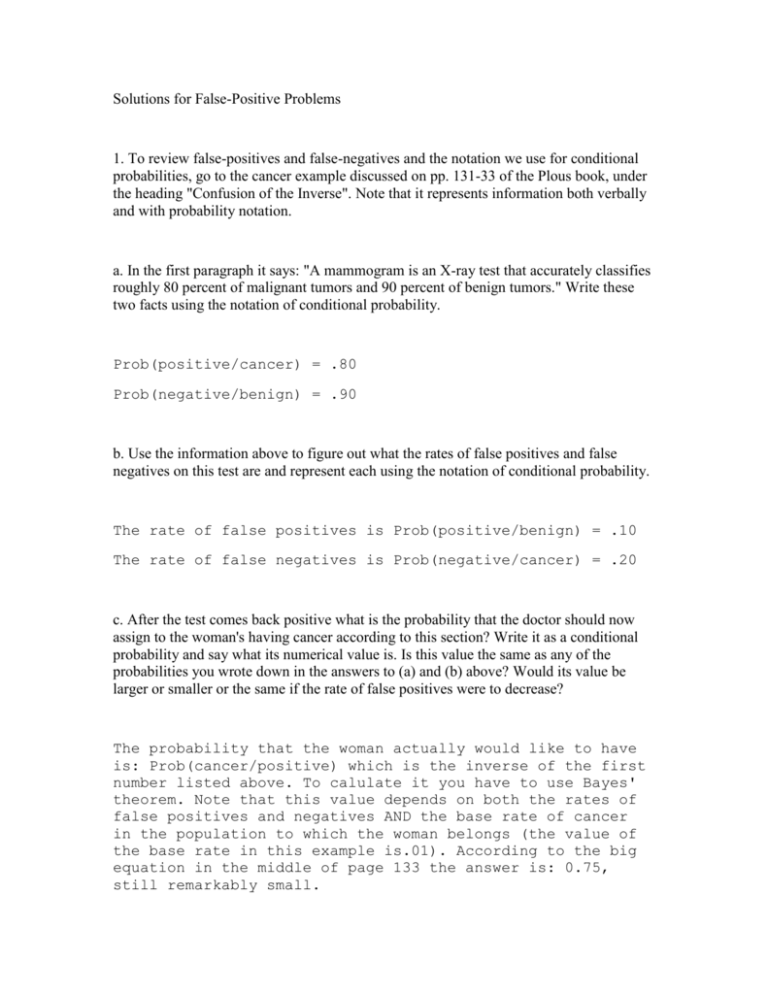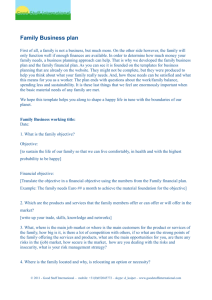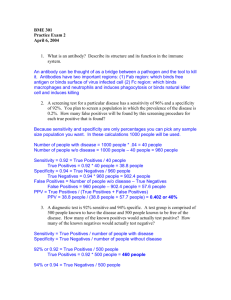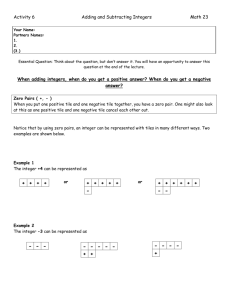Solutions for False
advertisement

Solutions for False-Positive Problems 1. To review false-positives and false-negatives and the notation we use for conditional probabilities, go to the cancer example discussed on pp. 131-33 of the Plous book, under the heading "Confusion of the Inverse". Note that it represents information both verbally and with probability notation. a. In the first paragraph it says: "A mammogram is an X-ray test that accurately classifies roughly 80 percent of malignant tumors and 90 percent of benign tumors." Write these two facts using the notation of conditional probability. Prob(positive/cancer) = .80 Prob(negative/benign) = .90 b. Use the information above to figure out what the rates of false positives and false negatives on this test are and represent each using the notation of conditional probability. The rate of false positives is Prob(positive/benign) = .10 The rate of false negatives is Prob(negative/cancer) = .20 c. After the test comes back positive what is the probability that the doctor should now assign to the woman's having cancer according to this section? Write it as a conditional probability and say what its numerical value is. Is this value the same as any of the probabilities you wrote down in the answers to (a) and (b) above? Would its value be larger or smaller or the same if the rate of false positives were to decrease? The probability that the woman actually would like to have is: Prob(cancer/positive) which is the inverse of the first number listed above. To calulate it you have to use Bayes' theorem. Note that this value depends on both the rates of false positives and negatives AND the base rate of cancer in the population to which the woman belongs (the value of the base rate in this example is.01). According to the big equation in the middle of page 133 the answer is: 0.75, still remarkably small. When there are fewer false positives, the positive test result becomes more reliable so the final answer would be greater than 7.5%. (The original rate of false positives in this example is .10. Since it appears in the denominator, decreasing its value would increase the value of p(cancer/positive), the number we're interested in.) 2. Attached is a shortened version of a recent news story about the accuracy of identifications based on fingerprints. If a fingerprint expert says there is a positive match between two sets of fingerprints but they in fact come from two different people, we will call such an error a "false positive". (What would a case of a "false negative" be?) False positive rate is Prob(report of positive match/actually came from different people) False negative rate isProb(report of no match/actually came from same person) Inserted into the linked story at various points are bold letters which refer to the following questions: i) Which kind of error is being referred to in this passage? “On a 1995 proficiency test of 156 examiners conducted with the approval of the International Association of Identification, the profession's certifying organization, one in five examiners made at least one misidentification -- linking a mock crime-scene print to the wrong person. Fingerprint experts point out that the error rate was lower on subsequent tests.” False positive j) Which kind in this passage? “In that case, both the prosecution and defense fingerprint experts mismatched a print to the defendant.” false positive k) Briefly describe two kind of medical misdiagnoses. Typically, which kind of error causes more harm to the patient. Briefly explain. "False positive: A result that is erroneously positive when a situation is normal. An example of a false positive: a particular test designed to detect cancer of the toenail is positive but the person does not have toenail cancer." Causes anxiety and costs money to retest. Test itself may cause a bit of damage to toe. "False negative: A result that appears negative but fails to reveal a situation. An example of a false negative: a particular test designed to detect cancer of the toenail is negative but the person has toenail cancer." Possibly one never detects cancer until toe must be amputated. More costly. l) What kind of error is under discussion here? “"If they want to go in and testify, 'I think it's his print and 1 percent of the time I'm wrong,' then that would be more reasonable," Mr. Cole said.” false positive m) What kind of error is under discussion here? What is the minimum value of the rate of error according to this study? “But 8 of the 34 laboratories that responded were unable to find a match for at least one of the two latent prints.” false negative n) In the typical case, which rate of error is a defense lawyer likely to be more interested in and employ in making the case for the defendant, the rate of false positives or the rate of false negatives? Very briefly explain your answer. If there is a high rate of false positives the defense can argue that the purported match is not very reliable as evidence linking the defendant to the crime. o) Fingerprints are a standard item used by detectives, who try to solve cases, but don't have to prosecute them. Which error rate will be of primary concern to them? A false negative report would send them off looking for another suspect unnecessarily. p) Suppose you are a suspect who has just been brought in and are being fingerprinted. You have heard that prints were found at the scene of the crime. As you are being fingerprinted would you be more or less nervous if you believed that fingerprinting is subject to a high rate of false positives? Answer the same question for a high rate of false negatives. Does your nervousness depend on whether or not you are guilty? Explain any other assumptions underlying your answers. I'd worry that a false positive report might result in my conviction! If I'm guilty I'd worry that they also have other evidence linking me to the crime. If I'm not guilty (and I have faith in the justice system and don't think that I'm being deliberately "set up" for something I didn't do), then I could realistically hope that other evidence, such as a good alibi, would indicate that I wasn't guilty. Both would like there to be a high rate of false negatives because then they wouldn't be accused -- even if guilty!











